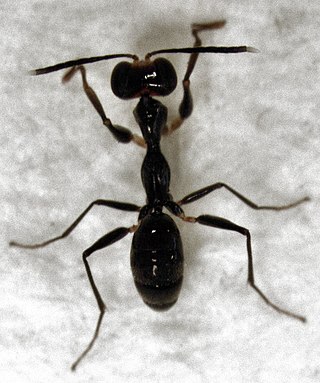
Dryinidae is a cosmopolitan family of solitary wasps. Its name comes from the Greek drys for oak: Latreille named the type genus Dryinus because the first species was collected on an oak tree in Spain. The larvae are parasitoids of the nymphs and adults of Auchenorrhyncha. Dryinidae comprises over 1900 described species, distributed in 11 extant subfamilies and 57 genera.

Baltic amber or succinite is amber from the Baltic region, home of its largest known deposits. It was produced sometime during the Eocene epoch, but exactly when is controversial. It has been estimated that this forested region provided the resin for more than 100,000 tons of amber. Today, more than 90% of the world's amber comes from Kaliningrad Oblast of Russia. It is a major source of income for the region; the local Kaliningrad Amber Combine extracted 250 tonnes of it in 2014 and 400 tonnes in 2015. Baltic amber is also found in Poland, as well as the Baltic states.
Paleontology or palaeontology is the study of prehistoric life forms on Earth through the examination of plant and animal fossils. This includes the study of body fossils, tracks (ichnites), burrows, cast-off parts, fossilised feces (coprolites), palynomorphs and chemical residues. Because humans have encountered fossils for millennia, paleontology has a long history both before and after becoming formalized as a science. This article records significant discoveries and events related to paleontology that occurred or were published in the year 1975.

Anteon is the largest genus in the subfamily Anteoninae of the family Dryinidae, it occurs globally and there is a current total of 464 species described. The species in the genus Anteon are parasitoids of leafhoppers from the family Cicadellidae. The female wasps of the family Dryinidae almost always possess a chelate protarsus, as do females of species within Anteon. The chelae are used to capture and immobilise the host leafhopper to allow the wasp to oviposit and feed on it.

Dryinus grimaldii is an extinct species of wasp in the dryinid genus Dryinus. The species is solely known from the early Miocene, Burdigalian stage, Dominican amber deposits on the island of Hispaniola.

Dryinus rasnitsyni is an extinct species of wasp in the dryinid genus Dryinus. The species is solely known from the early Miocene, Burdigalian stage, Dominican amber deposits on the island of Hispaniola.

Deinodryinus? aptianus is an extinct species of Deinodryinus in the wasp family Dryinidae. The species is solely known from a Cretaceous fossil found in Mongolia.

Deinodryinus velteni is an extinct species of Deinodryinus in the wasp family Dryinidae. The species is known solely from an Eocene fossil found in the Baltic region.

Arostropsis is an extinct genus of broad-nosed weevil in the beetle family Curculionidae known from an Upper Eocene fossil found in Europe. The genus contains a single described species, Arostropsis groehni.

Gonatopodinae are a subfamily of Dryinidae with wingless, ant-like females, but winged males. Females have a chela on each front leg. There are 17 genera, including Gonatopus.

Anteoninae are a subfamily of Dryinidae. There are 4 extant and 2 fossil genera, including Anteon. Characteristics of the subfamily include a 'mask' covering the frontal region of the larvae, an absence of cephalic vesicles, body folded in a U-shape, always found on the thorax or between metathorax and abdomen of the host, never between abdominal segments, with the subfamilial characteristics of mature larvae being "very long setae on body and head, (2) labrum with few long sensory bristles and two sensory pits at about mid-length between anterior and posterior margin and with an apical row of sensory bristles inserted immediately under its apical margin, (3) epipharynx with two sensilla, (4) labium subtriangular with narrow subquadrate spinneret, (5) spiracles bulb-shaped, of approximately equal size in thorax and abdomen, and (6) cocoon in the ground, covered by soil particles."
Thaumatodryinus tuukkaraski is a wasp species in the family Dryinidae. This tiny insect is endemic to Kenya where it is only known from the Taita Hills. In 2015, this newly discovered species was named in direct reference to former Boston Bruins (NHL) goaltender, Tuukka Rask.

Gonatopus is a genus of solitary wasps of the family Dryinidae, sometimes called hump-backed pincer wasps. The wingless females have large scissor-like appendages at the tips of the front legs which are used to catch the leafhopper nymphs which act as hosts to the larvae of these wasps. The larva consumes the leafhopper nymph from the inside. An indication that a leafhopper is hosting a grub is a cyst of accumulated shed integuments which surround and protect the growing wasp larva.
Gonatopus jacki is a species of small wasp in the family Dryinidae. It is found in United States.

Dryinus is a cosmopolitan genus of dryinid parasitic wasp. Over 242 species have been described worldwide. Numerous fossil species have been described from the Baltic, Dominican and Burmese ambers.
Jouault, Corentin; Rosse-Guillevic, Simon. "A new genus of praeaulacid wasp from the mid-Cretaceous Kachin amber (Myanmar)". Annales de Paléontologie. 109 (1): 102599. doi:10.1016/j.annpal.2023.102599.
Aphelopus is a genus of insects belonging to the family Dryinidae. It is recognizable by only one costal cell surrounded by pigmented veins.
The Prussian Formation, previously known as the Amber Formation, is a geologic formation in Prussia, today mostly Kaliningrad Oblast that dates to the Eocene. It holds 90% of the world's amber supply and Baltic amber is found exclusively in the Prussian Formation.
Embolemopsis is an extinct genus of wasps belonging to the family Embolemidae. Two species are known: the type species, E. baissensis from the Aptian Zaza Formation of Russia, and E. maryannae from the Barremian Wessex Formation of England.

Bocchus thorpei is a species of wasp belonging to the family Dryinidae. The species was first described by Massimo Olmi in 2007, and is known to occur in New Zealand.











